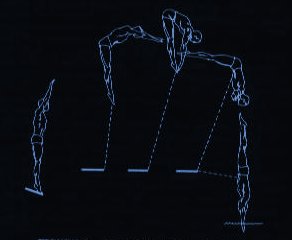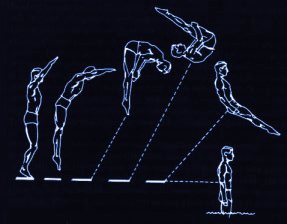To do a front dive (shown in Figure B) a diver pushes his hips upward just slightly as he leaves the board. After he had begun to go up into the air, he throws his arms downward just enough to make is upper torso rotate around his hips. At the peak of the dive, the diver tightens his stomach muscles and pulls his legs up towards the sky, leaving his body in a perfect upside-down position to enter the water head-first.
 Figure
B
Figure
B
Although it is not very obvious, conservation of angular momentum occurs here. A better example is with a front dive with a somersault (Figure C).
In order to perform a front dive with a somersault, it requires a full flip of the body and therefore it takes a quicker rotation to cover such an angular distance. The diver takes off from the diving board with the same hip motion and arm swing as for a forward dive, but throws the arms further and makes a smaller "ball" in the air. As is seen in the laws of rotational motion, the diver's moment of inertia becomes smaller, but since momentum must be conserved in the system, the angular speed increases to compensate.
It is important to note here that the reverse can be applied in order to stop the diver's rotation to keep him from doing a belly-flop on the water. To stop his rotation, the diver increases his moment of inertia by straightening his body, conserving momentum again.
 Figure
C
Figure
C